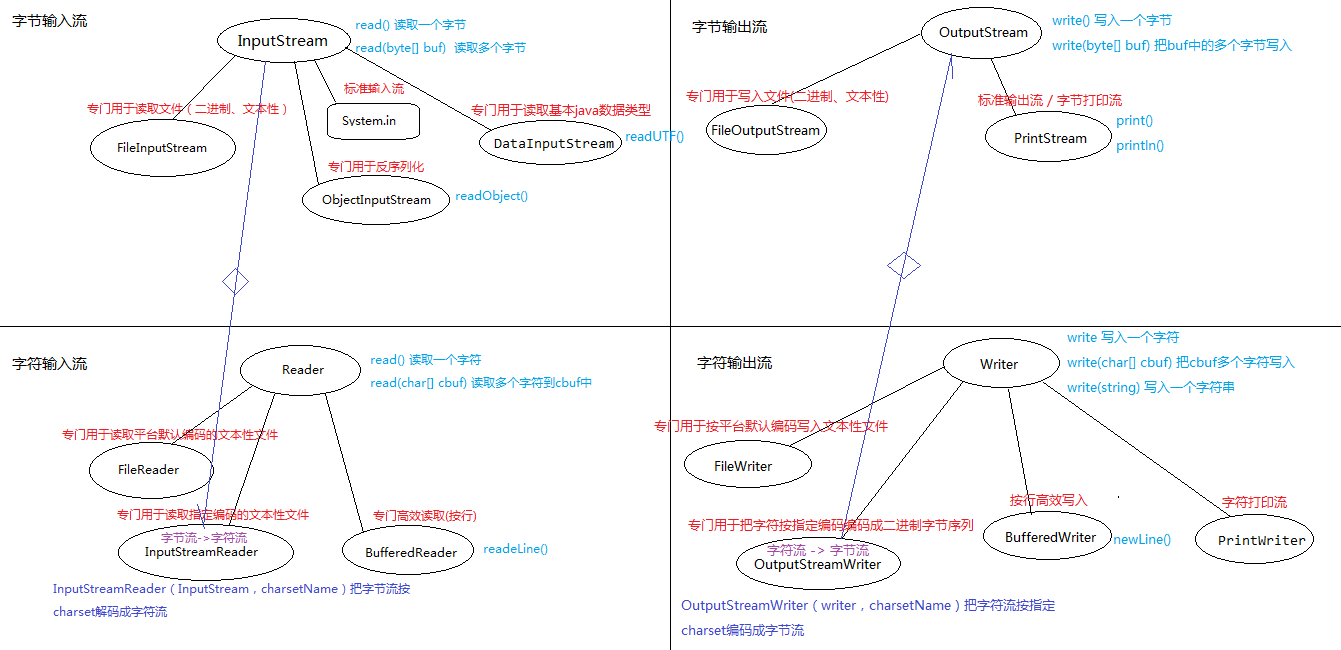1.标准输入输出流
1.1 标准输入流
源数据源是标准输入设备(键盘、鼠标、触摸屏)等输入设备。在java中用System.in 得到一个InputStream字节输入流。
需求:在控制台输入一句话,然后原样输出
1 public static void main(String[] args) throws IOException { 2 // 需求:输入一句话,然原样输出 3 InputStream in = System.in; 4 5 byte[] buf = new byte[1024]; 6 int len; 7 // buf中包含回车和换行 8 len = in.read(buf); 9 10 String str = new String(buf, 0, len); 11 // System.out.println(Arrays.toString(buf)); 12 System.out.println(str); 13 }
注意:
[1] 标准输入流以字节流流入内存,如果在控制台中输入字符,字符以默认编码(win简体:gbk)编码成字节进入标准输入流。
1 public static void main(String[] args) throws IOException { 2 // 需求:从控制台高效读取一行数据。把一首诗写入文件。 3 4 InputStream in = System.in; 5 InputStreamReader reader = new InputStreamReader(in, "GBK"); 6 BufferedReader br = new BufferedReader(reader); 7 8 File file = new File("d:\javatest\k.txt"); 9 FileWriter writer = new FileWriter(file); 10 BufferedWriter bw = new BufferedWriter(writer); 11 12 String end = "bye"; 13 while(true) { 14 String line = br.readLine(); 15 if(line.equals(end)) { 16 break; 17 } 18 19 bw.write(line); 20 // bw.newLine(); 21 } 22 23 bw.flush(); 24 25 bw.close(); 26 writer.close(); 27 28 }
1.2 标准输出流(PrintStream)
数据目的地是标准输出设备(显示器)等输出设备。在java中用System.out得到一个PrintStream 字节输出流(字节打印流)。提供了更强大的
println
打印方法用于打印各种数据类型。
需求:读取文件,显示到标准输出设备
1 public static void main(String[] args) throws IOException { 2 3 File file = new File("d:\javatest\k.txt"); 4 5 FileReader reader = new FileReader(file); 6 BufferedReader br = new BufferedReader(reader); 7 8 PrintStream ps = System.out; 9 10 String line; 11 while( (line=br.readLine())!=null ) { 12 ps.println(line); 13 } 14 }
PrintStream 打印的所有字符都使用平台的默认字符编码转换为字节。
1 public static void main(String[] args) throws IOException { 2 3 4 String str = "hello中国"; 5 byte[] buf = str.getBytes("utf-8"); 6 7 PrintStream ps = System.out; 8 ps.write(buf); 9 10 }
2.序列化
把内存中的对象永久保存到硬盘的过程称为对象序列化,也叫做持久化。
把硬盘持久化的内存恢复的内存的过程称为对象反序列化。
2.1 Serializable
类通过实现 java.io.Serializable 接口以启用其序列化功能。未实现此接口的类将无法使其任何状态序列化或反序列化,并抛出异常
1 Exception in thread "main" java.io.NotSerializableException: cn.sxt05.serializable.Student 2 at java.io.ObjectOutputStream.writeObject0(ObjectOutputStream.java:1184) 3 at java.io.ObjectOutputStream.writeObject(ObjectOutputStream.java:348) 4 at cn.sxt05.serializable.Test01.main(Test01.java:22)
Serializable接口没有方法或字段,仅用于标识可序列化的语义
public class Student implements Serializable{
2.2 序列化对象
ObjectOutputStream 继承于OutputStream,专门用于把对象序列化到本地。提供了
writeXXX
writeObject() 用于写入一个对象
1 public static void main(String[] args) throws IOException { 2 3 Student stu = new Student("001", "大狗", 20, Gender.男); 4 5 /** 6 * 方案1:取stu所有的属性,通过特定的字符串(-),把各个属性值连接起来 7 * 001-大狗-20-男 8 */ 9 10 File file = new File("d:\javatest\l.txt"); 11 FileOutputStream out = new FileOutputStream(file); 12 ObjectOutputStream oos = new ObjectOutputStream(out); 13 14 oos.writeObject(stu); 15 16 oos.close(); 17 out.close(); 18 }
2.3 反序列化对象
ObjectInputStream 继承于InputStream ,专门用于把本地持久化内容反序列化到内存,提供了
readXXX
readObject() 用于读取一个序列化内容并返回一个对象。
1 public static void main(String[] args) throws IOException, ClassNotFoundException { 2 3 File file = new File("d:\javatest\l.txt"); 4 5 6 FileInputStream in = new FileInputStream(file); 7 ObjectInputStream ois = new ObjectInputStream(in); 8 9 Student student = (Student) ois.readObject(); 10 System.out.println(student.getId()); 11 System.out.println(student.getName()); 12 System.out.println(student.getAge()); 13 System.out.println(student.getGender()); 14 15 ois.close(); 16 in.close(); 17 }
2.4 序列化版本
当序列化完成后,后期升级程序中的类(Student),此时再反序列化时会出现异常。
1 Exception in thread "main" java.io.InvalidClassException: cn.sxt05.serializable.Student; local class incompatible: stream classdesc serialVersionUID = -6288733824962181189, local class serialVersionUID = 1690603786167234505 2 at java.io.ObjectStreamClass.initNonProxy(ObjectStreamClass.java:687) 3 at java.io.ObjectInputStream.readNonProxyDesc(ObjectInputStream.java:1876) 4 at java.io.ObjectInputStream.readClassDesc(ObjectInputStream.java:1745) 5 at java.io.ObjectInputStream.readOrdinaryObject(ObjectInputStream.java:2033) 6 at java.io.ObjectInputStream.readObject0(ObjectInputStream.java:1567) 7 at java.io.ObjectInputStream.readObject(ObjectInputStream.java:427) 8 at cn.sxt05.serializable.Test02.main(Test02.java:16)
异常原因:序列化流的serialVersionUID和升级后类的版本不匹配。
解决方案:给Student类加序列化版本号,有两种方式

default serial version ID 生成默认的serial version ID 一般值都是1L。
generated serial version ID 根据当前类的属性、方法生成一个唯一ID。
1 public class Student implements Serializable { 2 3 private static final long serialVersionUID = -1003763572517930507L;
2.5 transient
开发过程中,如果想忽略某些字段不让其序列化时,可以使用transient修饰。
1 public class Student implements Serializable { 2 3 private static final long serialVersionUID = 7222966748321328300L; 4 5 private String id; 6 private transient String name; 7 private transient int age; 8 private Gender gender; 9 private String phone;
3. DataInputStream/DataOutputStream
DataOutputStream 继承OutputStream,专门用于把基本java数据类型写入输出流。提供了writeXXX 写入基本java数据类型。
DataInputStream 继承于InputStream,允许应用程序以与机器无关方式从底层输入流中读取基本 Java 数据类型。
DataInputStream/DataOutputStream 特别适合读取/写入在网络传输过程中的数据流。
写入基本java数据类型
1 public static void main(String[] args) throws IOException { 2 3 File file = new File("d:\javatest\n.txt"); 4 FileOutputStream out= new FileOutputStream(file); 5 DataOutputStream dos = new DataOutputStream(out); 6 7 dos.writeInt(10); 8 dos.writeUTF("hello中国"); 9 10 dos.close(); 11 out.close(); 12 13 System.out.println("写入完成"); 14 15 }
读取基本java数据类型
1 public static void main(String[] args) throws IOException { 2 3 File file = new File("d:\javatest\n.txt"); 4 FileInputStream in = new FileInputStream(file); 5 DataInputStream dis = new DataInputStream(in); 6 7 int a = dis.readInt(); 8 String str = dis.readUTF(); 9 10 System.out.println(a); 11 System.out.println(str); 12 13 }
流的系统分类
